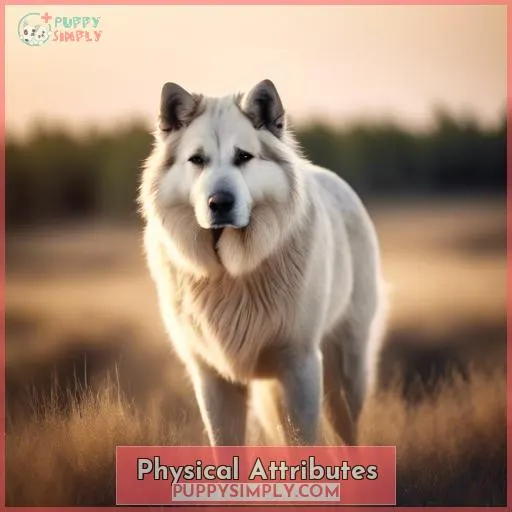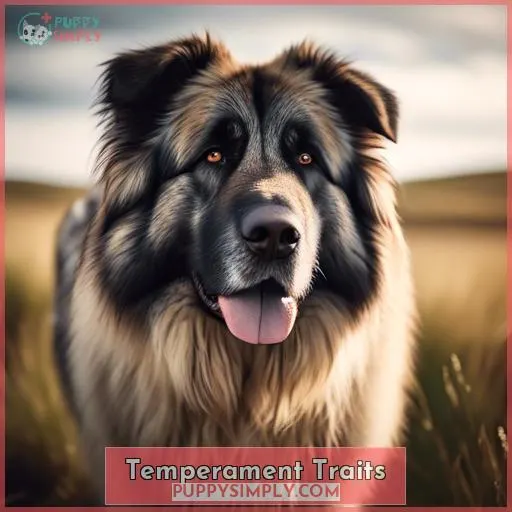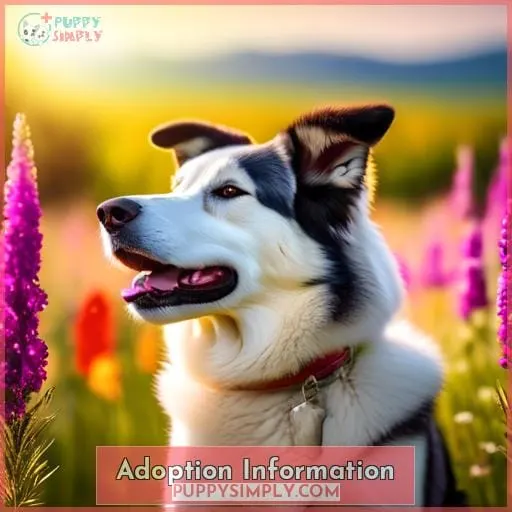This site is supported by our readers. We may earn a commission, at no cost to you, if you purchase through links.
 Discover the noble Central Asian Shepherd, a breed that embodies strength and loyalty.
Discover the noble Central Asian Shepherd, a breed that embodies strength and loyalty.
You’ll find their protective nature and robust build offer unparalleled security, while their affectionate side ensures a deep bond with family.
This guide will navigate you through their care, from managing their thick coat to meeting their exercise needs, ensuring your majestic guardian remains both healthy and content.
Embrace the journey of companionship with a dog that’s been a symbol of power for centuries.
Table Of Contents
- Key Takeaways
- Breed Overview
- Historical Significance
- Physical Attributes
- Temperament Traits
- Training Challenges
- Exercise Requirements
- Grooming Essentials
- Nutritional Needs
- Health and Wellness
- Adoption Information
- Frequently Asked Questions (FAQs)
- How do Central Asian Shepherds interact with other household pets, especially smaller ones?
- Can Central Asian Shepherds adapt to living in colder climates given their origins in warmer regions?
- What are the legal considerations for owning a Central Asian Shepherd, such as breed-specific legislation or insurance challenges?
- How do Central Asian Shepherds typically react to unfamiliar visitors or service personnel entering their home environment?
- Are there any cultural significance or traditional roles for Central Asian Shepherds in their countries of origin that are not related to herding or guarding?
- Conclusion
Key Takeaways
- The Central Asian Shepherd Dog is known for its protective instincts, deep family bonds, and wariness of strangers, making it an excellent guardian of livestock and homes with a strong and independent nature.
- These dogs have a long lifespan of 12-17 years and require regular veterinary care, including genetic screening for early detection of conditions like hip dysplasia and dystrophic epidermolysis bullosa, to ensure their health and wellness.
- Physically, males can reach up to 32 inches in height and weigh up to 170 pounds, featuring a muscular build, broad chest, and a coat that can be short or long in various colors.
- Originating from ancient nomadic cultures of Central Asia, these dogs have played a pivotal role in cultural evolution and are revered in Turkmenistan, symbolized by a gold statue, highlighting their historical significance and legacy.
Breed Overview
When considering the Central Asian Shepherd, you’re looking at a breed that’s as robust in character as it is in physique. These dogs are part of the Working Group, known for their protective, adaptable, and trainable nature, alongside a strong and independent streak.
With a lifespan ranging from 12 to 17 years, their health and vitality are paramount. This requires a commitment to proper care and regular veterinary check-ups to maintain their well-being.
Working Group Characteristics
In the world of working dogs, the Central Asian Shepherd stands out for its combination of strength, independence, and protective instincts, making it an exemplary member of the Working Group.
Its working dynamics and task suitability are unparalleled, especially as a guard dog.
Despite facing occupational challenges, with proper diet, nutrition, and care, this breed excels in job performance and utilization potential, minimizing health problems.
Lifespan and Health
You’ll find that Central Asian Shepherd Dogs typically have a lifespan ranging from 12 to 15 years, and maintaining their health requires attention to diet, exercise, and regular veterinary care.
- Longevity tips: Regular check-ups and preventative care to avoid common ailments.
- Exercise benefits: Daily walks enhance their role as a working and guardian dog.
- Dietary considerations: Balanced meals tailored to their needs.
- Genetic health conditions: Be aware of skin disorders and other inheritable issues.
Historical Significance
The Central Asian Shepherd, with its ancient origins and cultural symbolism, holds a significant place in the history of Central Asia.
This breed, revered for its protective nature and adaptability, has been a symbol of pride and national heritage, especially in Turkmenistan where it is celebrated with a gold statue.
Their role as guardians, both of livestock and homes, showcases their importance in the region’s way of life.
Ancient Origins
With origins stretching back over millennia, the Central Asian Shepherd’s ancestors were pivotal to the nomadic cultures of Central Asia. These ancient migration partners provided prehistoric protection and played a significant role in the cultural evolution of the region.
Their genetic resilience ensured survival and adaptation across diverse terrains, from deserts to snowy mountains.
As a powerful, large, and territorial dog, the Central Asian Ovtcharka evolved from these ancient breeds. It embodies the spirit of its forebears while safeguarding the nomadic companions of old.
Cultural Symbolism
Transitioning from the ancient origins of the Central Asian Shepherd, we now delve into its profound cultural symbolism, reflecting its status as a revered emblem of national heritage and pride across Central Asia.
This loyal and protective dog, deeply rooted in Middle Eastern and African heritage, embodies the essence of historical guardians.
Its representation in folklore underscores a rich cultural symbolism, celebrating the breed’s role as a steadfast livestock guardian. The Central Asian Shepherd’s symbolic significance extends beyond mere companionship, symbolizing strength, resilience, and unwavering loyalty, hallmarks of national pride and cultural heritage.
Physical Attributes
When exploring the physical attributes of the Central Asian Shepherd, you’ll find they’re as impressive as they are functional. Their size and build reflect a history of guarding and protection, with males standing up to 32 inches and weighing as much as 170 pounds.
The variety in their coat, which can be short or long and comes in a range of colors except blue and brown, offers adaptability to various climates. This ensures they’re well-equipped for their roles as both guardians and companions.
Size and Build
Reflecting on their historical role as formidable guardians, Central Asian Shepherds exhibit a commanding presence with their impressive size and muscular build. Their physical attributes are a testament to their strength and agility, necessary for their protective duties.
- Muscular stature: These dogs are built for endurance and strength, making them capable guardians.
- Broad chest: This feature contributes to their powerful appearance and respiratory efficiency.
- Massive build: Males can weigh between 100-150lbs, and females 80-110lbs, showcasing their imposing size.
- Triangular ears and thick tail: These distinctive features complement their alert and ready-to-protect demeanor.
Central Asian Shepherds aren’t just loving dogs; they’re equipped with a physique that commands respect and ensures safety.
Coat Varieties
From their muscular frame and impressive stature, Central Asian Shepherds boast a variety of coat types to suit their environment. You can expect their outer coat to range from short to long, with a straight, coarse undercoat providing insulation.
Their coat coloration spans a wide spectrum, including shades of black, fawn, brindle, and white, among others. The length variation and texture diversity of their coats are adapted to the harsh climates they originated from.
Seasonal shedding is significant, requiring more frequent grooming during these periods to manage the undercoat density. Despite their independent and strong-willed nature, these dogs are wary of strangers, a trait that underscores their protective instincts.
The dense undercoat plays a crucial role, not just in insulation, but also in potentially reducing irritations in the oral cavity by trapping debris.
Temperament Traits
As you explore the temperament of the Central Asian Shepherd, you’ll find their protective instincts are a defining trait. These dogs form deep bonds with their families, often becoming fiercely loyal guardians.
Understanding these characteristics is key to fostering a harmonious relationship with this noble breed.
Protective Instincts
The Central Asian Shepherd’s muscular build and thick coat are well-suited to their role as protectors. Their physical attributes are complemented by their innate protective instincts, which are essential to understand and manage effectively.
Their guarding behavior and instinctive loyalty make them exceptional protectors. It is important to understand their territoriality, as it fuels their protective instincts, leading to defensive reactions if they perceive a threat to their family.
Family Bonds
Central Asian Shepherds exhibit an unwavering devotion to their families, a trait that seamlessly transitions from their protective instincts. You’ll notice their affection through their vigilant presence and subtle displays of loyalty, rather than overt gestures of warmth.
Engage in bonding activities to foster family integration, employing socialization techniques that deepen emotional connections.
Training Challenges
When training your Central Asian Shepherd, you’ll quickly discover their independent nature can be a hurdle.
It’s crucial to start socialization early to ensure they’re well-adjusted and manageable.
Despite their protective instincts, with consistent guidance, they can become obedient and loyal companions.
Independent Nature
You’ll find that the Central Asian Shepherd’s independent nature presents unique training challenges, requiring patience and consistency.
Overcoming behavioral challenges demands understanding and adaptability. Employing socialization techniques early on is crucial for their development.
Handling their independence with care fosters a strong bond. Through tailored bonding strategies, you’ll gain control, ensuring both safety and a harmonious relationship.
Socialization Importance
Understanding the independent nature of the Central Asian Shepherd, transitioning to emphasizing the importance of socialization can’t be overstated. It’s crucial you start socializing your dog early, exposing them to a variety of people, animals, and environments to ensure they grow into well-adjusted adults.
Canine companionship builds trust, while puppy parties offer controlled interactions.
Positive exposure familiarizes them with surroundings, overcoming training challenges and fears.
Exercise Requirements
As a Central Asian Shepherd owner, you should be aware that while your dog may not be the most active breed, they still require regular exercise to maintain their health and happiness.
These dogs are known for their moderate energy levels and benefit from daily walks or play sessions to keep them mentally and physically stimulated.
It’s important to provide them with activities that cater to their natural instincts and abilities, ensuring a well-rounded exercise routine.
Energy Levels
The Central Asian Shepherd’s exercise needs, while not as demanding as some breeds, still require your consistent attention to maintain their health and happiness.
They possess high endurance and thrive on moderate activity.
Daily walks are essential for their well-being, offering both physical exercise and mental stimulation.
Outdoor adventures and vigorous play in a secure area can satisfy their need for activity, keeping them balanced and content.
Suitable Activities
Transitioning from discussing their energy levels, it’s crucial you’re aware that Central Asian Shepherds thrive on activities that cater to their guarding instincts and moderate energy.
Outdoor adventures offer both mental stimulation and physical exercise.
Incorporating obedience training strengthens their socialization skills, crucial for aggression management.
These activities not only keep them fit but also ensure they’re well-adjusted, confident protectors of their domain.
Grooming Essentials
When it comes to grooming your Central Asian Shepherd, you’ll find the process relatively straightforward most of the year. Their coat requires minimal attention, with weekly brushing typically sufficing to keep it in good condition.
However, during their annual shedding period, known colloquially as the fur storm, daily grooming is necessary to manage the increased hair loss.
Don’t forget regular dental care and nail trimming to maintain their overall health and comfort.
Shedding Management
Every Central Asian Shepherd owner must prepare for the substantial fur storm during their pet’s annual shedding period.
Regular brushing becomes crucial to manage the shedding season effectively. By maintaining a consistent fur maintenance schedule, you’ll keep shedding control in check.
Dealing with shedding is easier with the right tools and commitment to your dog’s coat health.
Dental and Nail Care
Moving on from the fur storm of their annual shedding, you’ll want to focus on keeping your Central Asian Shepherd’s teeth and nails in top condition.
Preventative measures include regular tooth brushing to maintain oral hygiene and periodontal health.
Nail trimming is essential, too, ensuring your dog’s comfort and mobility.
These steps are key to your companion’s overall well-being.
Nutritional Needs
Nutritional Needs of the Central Asian Shepherd
When it comes to feeding your Central Asian Shepherd, it’s essential to focus on a diet that supports their robust size and active lifestyle. They’ll thrive on meals that are well-balanced and rich in nutrients, tailored to their specific energy requirements.
Remember to monitor their food intake closely and adjust portions as needed to maintain a healthy weight, consulting with your vet for personalized dietary guidance.
Diet Formulation
Shifting from grooming to diet, you’ll find that feeding your Central Asian Shepherd a balanced and nutritious diet is crucial for maintaining their health and vitality.
Prioritize balanced nutrition to support their muscular build and weight management.
Ensure digestive health with high-quality proteins and avoid common allergens.
Consult your vet about dietary supplements to enhance their diet and overall well-being.
Feeding Schedule
After understanding the importance of a well-proportioned and nutritious diet for your Central Asian Shepherd, it’s crucial to establish a consistent feeding schedule to maintain their health and vitality.
You should feed your adult Central Asian Shepherd twice a day, dividing their daily food intake into two meals to support optimal digestion and energy levels.
Scheduled meals help prevent overeating, while portion control is key to avoiding obesity.
Incorporate dietary supplements if needed, and always manage hydration.
Regular weight monitoring ensures your dog maintains a healthy weight.
Health and Wellness
When it comes to the health and wellness of your Central Asian Shepherd, it’s essential to be aware of their genetic predispositions and the importance of regular veterinary care.
While this breed is known for its robust health, they can still be prone to conditions like hip dysplasia and dystrophic epidermolysis bullosa.
Regular check-ups with a veterinarian can help catch and manage any health issues early, ensuring your dog leads a happy, healthy life.
Genetic Conditions
While a well-balanced diet is crucial for the Central Asian Shepherd’s overall health, it’s also important to be aware of the breed’s predisposition to certain genetic conditions. You’ll need to keep an eye out for signs of hip dysplasia, elbow dysplasia, and dystrophic epidermolysis bullosa, among others.
- Hip Dysplasia: Joint malformation causing pain and mobility issues.
- Elbow Dysplasia: Similar joint concerns affecting the forelimbs.
- Dystrophic Epidermolysis Bullosa: Skin blisters that require careful management.
- Genetic Screening: Essential for early detection and Veterinary Management.
Veterinary Care
To ensure your Central Asian Shepherd maintains optimal health, you’ll need to partner closely with a veterinarian who understands the unique needs of this breed.
Preventive measures, including routine check-ups and a tailored vaccination schedule, are crucial.
Your vet will also guide you on parasite prevention and the importance of dental hygiene, ensuring your dog’s well-being.
Adoption Information
When considering adding a Central Asian Shepherd to your family, it’s crucial to explore both breeder and rescue options.
Reputable breeders can provide a healthy, well-socialized puppy, ensuring a good start in life.
Alternatively, rescue organizations offer the opportunity to give a deserving dog a second chance, often with the benefit of knowing the dog’s temperament and needs.
Both paths have their merits, and your choice should align with your preferences and lifestyle.
Finding a Breeder
Considering the health and wellness of a Central Asian Shepherd, finding a reputable breeder who prioritizes genetic testing and proper veterinary care for their puppies is crucial.
Ensure they perform thorough health screening, trace parental lineage, and employ effective socialization techniques.
Rescue Options
After exploring breeder options, you might also consider adopting a Central Asian Shepherd through rescue organizations, where you’ll find dogs in need of a permanent home.
Sanctuary shelters and community outreach often facilitate these adoptions.
Foster programs provide temporary care, while rehabilitation efforts ensure the dogs are ready for family life.
Keep an eye out for adoption events to meet your new loyal companion.
Frequently Asked Questions (FAQs)
How do Central Asian Shepherds interact with other household pets, especially smaller ones?
Central Asian Shepherds can be good with other household pets, especially if they’re raised together.
However, they may need supervision around unfamiliar animals. Early socialization is key to fostering harmony.
Can Central Asian Shepherds adapt to living in colder climates given their origins in warmer regions?
Despite their warm-region ancestry, Central Asian Shepherds boast a thick double coat.
Their adaptability to diverse climates ensures comfort in frosty environments.
What are the legal considerations for owning a Central Asian Shepherd, such as breed-specific legislation or insurance challenges?
You’ll need to check local laws for breed-specific legislation. Owning a Central Asian Shepherd may affect your insurance policy due to their protective nature.
How do Central Asian Shepherds typically react to unfamiliar visitors or service personnel entering their home environment?
Despite what you might think, Central Asian Shepherds can be wary and even aggressive towards unfamiliar visitors or service personnel, due to their protective and territorial nature.
They’re not just big softies with everyone.
Are there any cultural significance or traditional roles for Central Asian Shepherds in their countries of origin that are not related to herding or guarding?
In their countries of origin, Central Asian Shepherds traditionally serve as guardians for property and settlements, not just herding or guarding livestock.
They’re valued companions, symbolizing strength and protection.
Conclusion
As a tapestry weaves together diverse threads to create a resilient and beautiful piece, so does the Central Asian Shepherd blend strength with tenderness.
You’re now equipped to nurture this noble breed, ensuring their loyalty and vigor shine through.
With proper care, exercise, and training, your guardian will thrive.
Embrace the journey with your Central Asian Shepherd, a living symbol of heritage and devotion, and enjoy the unwavering companionship that has stood the test of time.















